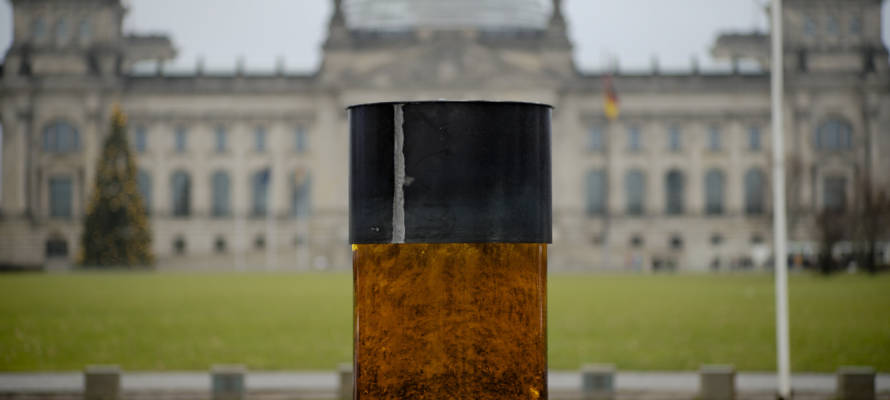The exhibit has sparked outrage for violating Jewish ritual law and dishonoring the memories of those who perished in the Holocaust.
By United with Israel Staff
The Center for Political Beauty installed, on Monday, an exhibit on the grounds of the former Kroll Opera House, near the Bundestag German federal parliament. The urn-like structure appears to contain the ashes and bones of Jews murdered by the Nazis. The exhibit is meant as a protest-call against German Chancellor Angela Merkel’s conservatives about the dangers of working with right-wing extremists.
The display, dubbed the “Resistance Column,” is a large, grey metal tube with an orange illuminated glass area in which soil that contains the human remains of Holocaust victims floats.
The Center’s website describes itself as “an assault team that establishes moral beauty, political poetry and human greatness while aiming to preserve humanitarianism. The group’s basic understanding is that the legacy of the Holocaust is rendered void by political apathy, the rejection of refugees and cowardice. It believes that Germany should not only learn from its History but also take action.”
It also credits itself for engaging in “the most innovative forms of political performance” that “must hurt, provoke and rise in revolt,” an endeavor it describes “aggressive humanism.”
The group said it spent “two years digging up soil and testing rivers near areas where the ‘Nazis perfected and industrialized mass murder,'” according to DW. “At one of the horrific sites we found ashes and bone char a meter deep. This column contains the sample from this soil that has been preserved for all eternity.”
Over that time, the Center said “it collected over 240 samples from 23 locations across Germany as well as in previously Nazi-occupied areas in Poland and Ukraine,” according to DW. Samples were taken from areas near Auschwitz, Sobibor, Treblinka and other concentration camps where ashes and remains of Holocaust victims were spread in nearby fields and rivers.
Human remains were found in over 70 percent of soil samples sent to a lab, the group said in a statement.
The Center said that the placement of the display was chosen intentionally as it is the site where German members of parliament gave dictator Adolf Hitler virtually unlimited authority in 1933.
The Central Council of Jews in Germany said that the display was “problematic,” while recognizing that fighting against rising far-right extremism is important.
“From a Jewish perspective, the Center for Political Beauty’s latest campaign is problematic because it violates Jewish religious law about not disturbing the dead,” council president Josef Schuster told DW in a statement.
Schuster added that, when the display is dismantled, a rabbi should be consulted to “ensure, at least, a respectful and correct handling of the ashes according to Jewish law.”
The exhibit is scheduled to remain in place until Saturday. The ‘artists’ have set up a crowdfunding campaign to raise funds in order to pour concrete around the urn and make it a permanent memorial.




